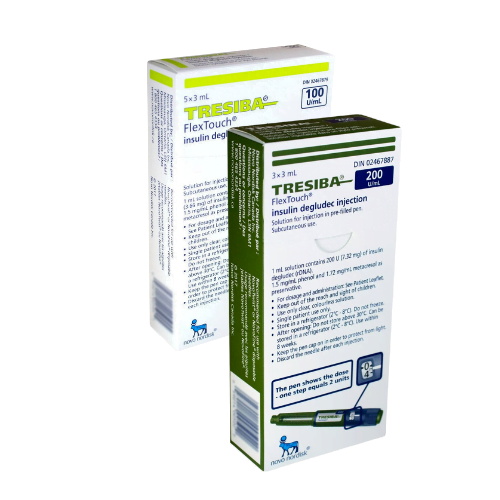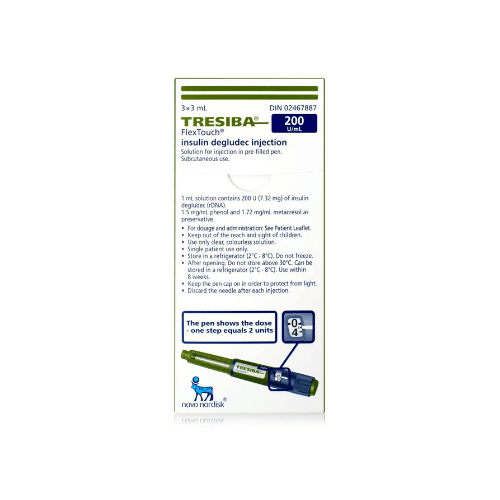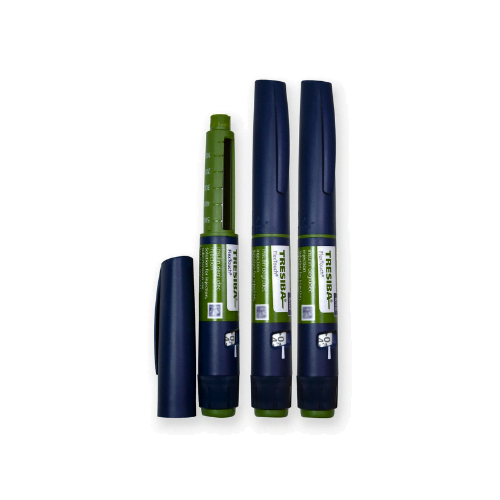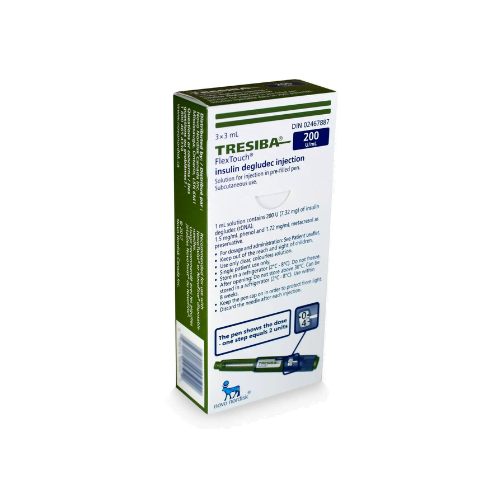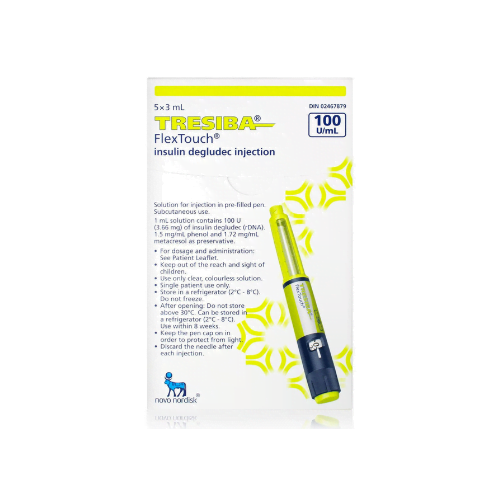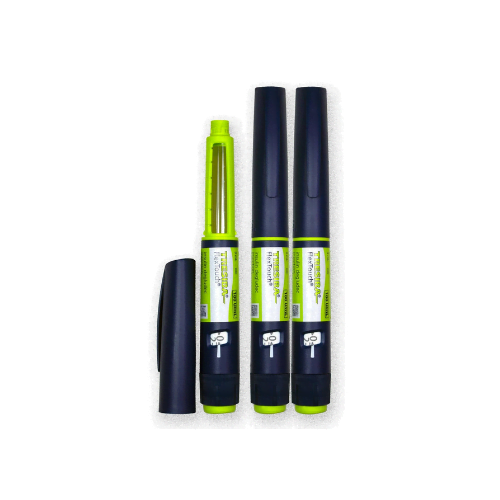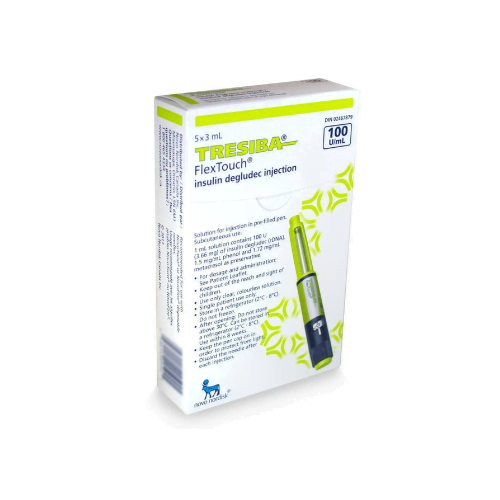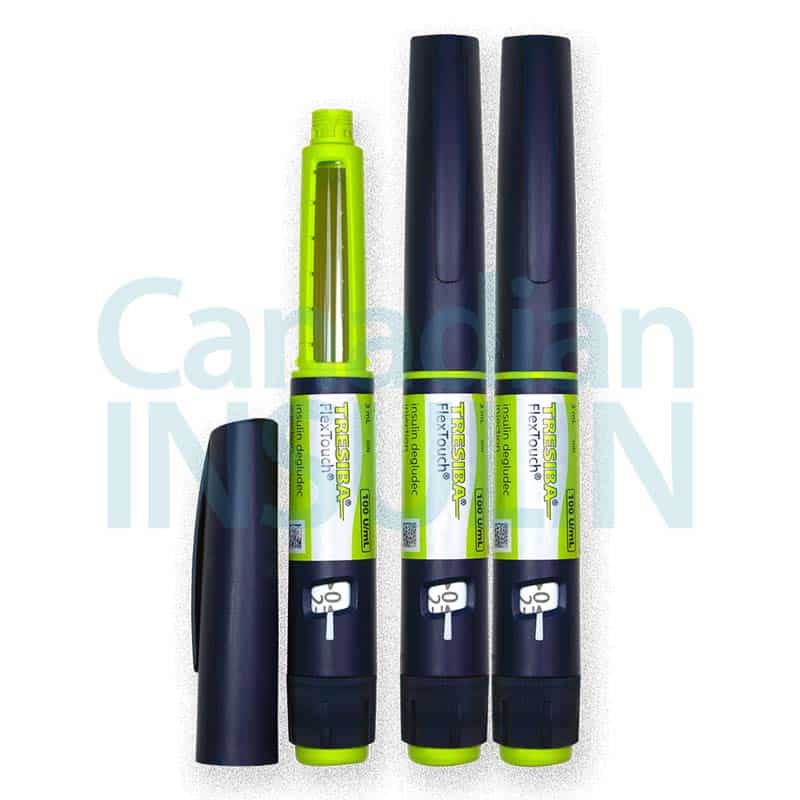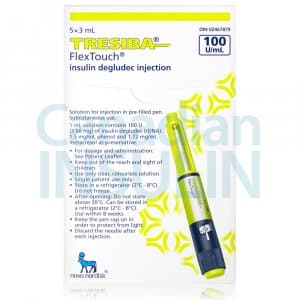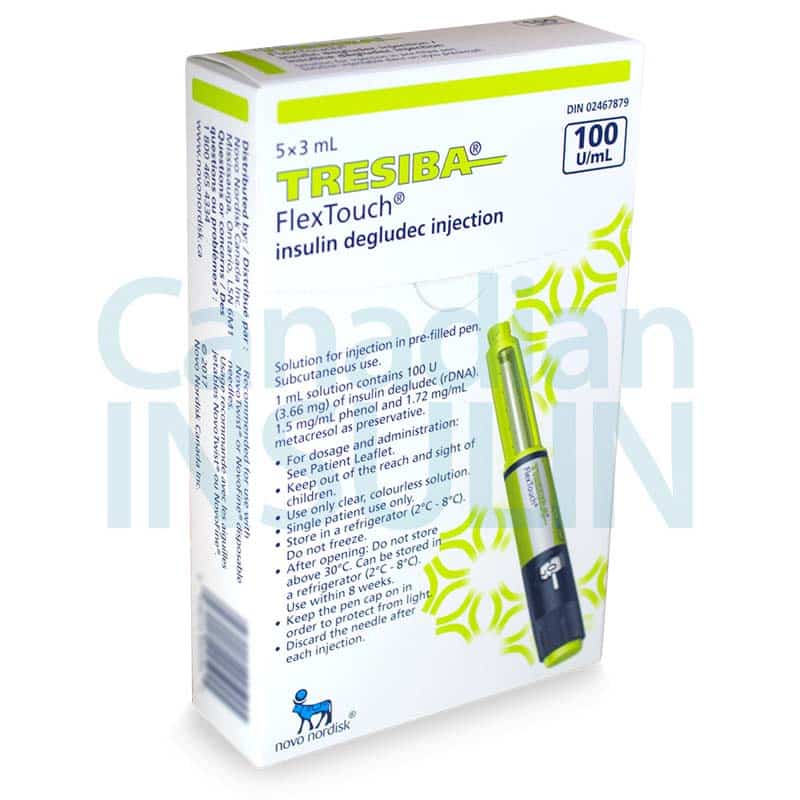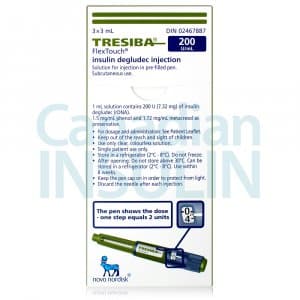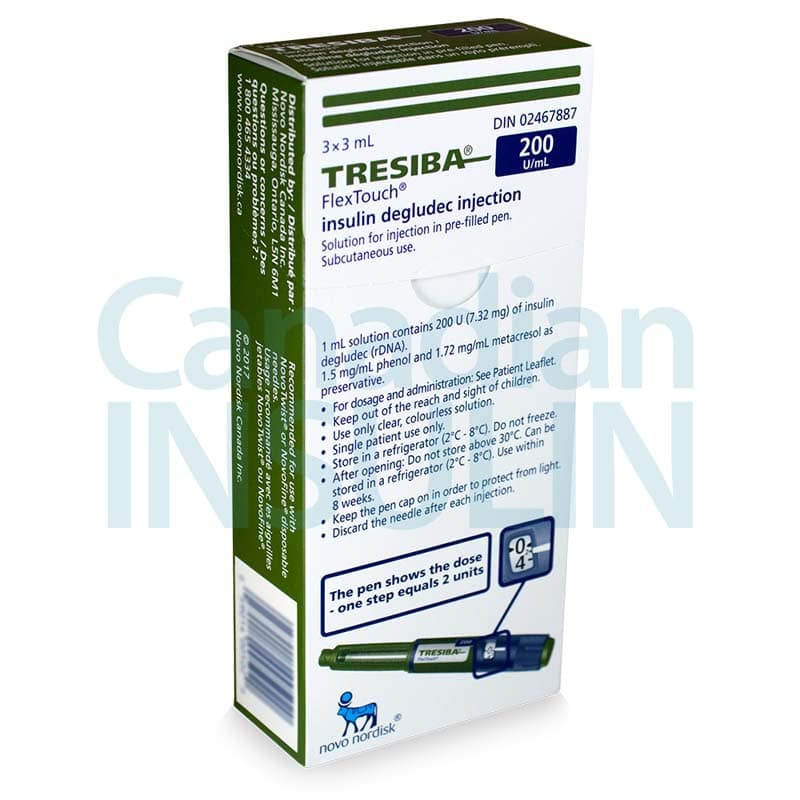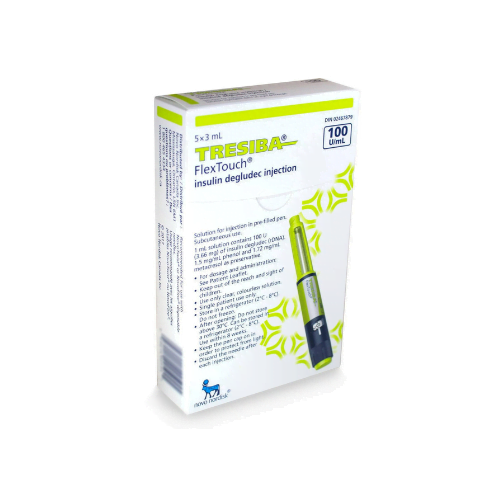Please note: a valid prescription is required for all prescription medication.
Tresiba® FlexTouch Pens for Diabetes
Sitewide Super Sale - Get 15% off when you buy 3 or more of the same product using the code LESS15 at checkout.
Applies to all products originating from Canada. Maximum quantity limited to a 90-day supply per order.
Price range: $163.00 through $183.00
You save


Tresiba FlexTouch Pens are prefilled insulin pens containing insulin degludec for basal glucose control. They help manage blood sugar in adults and children with diabetes. This page summarizes clinical facts, practical use, and US shipping from Canada, plus details on Tresiba FlexTouch cost without insurance.
What Tresiba Is and How It Works
Tresiba® is insulin degludec, a long-acting (basal) insulin. After subcutaneous injection, the molecule forms multi-hexamers in the subcutaneous tissue, creating a depot that slowly releases insulin into the bloodstream. This produces a flat, prolonged effect profile with once-daily administration. It supports fasting and between-meal glucose control.
CanadianInsulin.com is a prescription referral platform. We verify prescriptions with your prescriber when required, and licensed Canadian pharmacies dispense your order.
The treatment is used alongside nutrition planning, activity, and, when appropriate, rapid-acting insulin at meals. Use consistent technique and rotate injection sites to reduce skin changes such as lipodystrophy.
For a quick overview of delivery methods, see the discussion in Insulin Pen vs Syringe.
Who It’s For
This medicine is indicated to improve glycemic control in adults and pediatric patients with type 1 and type 2 diabetes. In type 1 diabetes, it is used with rapid-acting insulin to cover meals. In type 2 diabetes, it may be used alone or with other non-insulin agents when basal insulin is needed.
Do not use during episodes of hypoglycemia. Avoid if you have a known hypersensitivity to insulin degludec or any component. It is not appropriate for treating diabetic ketoacidosis. Learn more about conditions in Type 1 Diabetes and Type 2 Diabetes resources.
Dosage and Usage
Use once daily at the same time each day, or at a different time if necessary, ensuring adequate spacing per the label. The dose in units is individualized based on fasting glucose targets, meals, activity, and concurrent medicines. Your prescriber will outline titration steps after reviewing glucose logs.
Administration basics: inject subcutaneously in the abdomen, thigh, or upper arm. Rotate sites with each dose. Use a new pen needle for every injection and prime according to the pen instructions. Read the full Instructions for Use included with the pen before the first dose.
Type 1 diabetes: use as the basal component plus a rapid-acting insulin with meals. Type 2 diabetes: may be used as basal monotherapy or combined with other glucose-lowering agents. For general concepts, review the Insulin Dosage Chart and technique guidance in Pen Needles.
Strengths and Forms
The FlexTouch prefilled pen is available in two concentrations commonly published in labeling: 100 units/mL (U-100) and 200 units/mL (U-200). Each pen contains 3 mL of solution. Packaging options may include a carton of multiple pens; availability can vary by dispensing pharmacy and jurisdiction.
Missed Dose and Timing
If a dose is missed, take it when remembered, then resume the usual schedule. Allow at least several hours between injections as directed in the official label. Do not take two doses at once. Contact your clinician for individualized adjustments if multiple doses are missed.
Storage and Travel Basics
Unopened pens should be refrigerated as directed in the product label and not frozen. In-use pens may be kept at room temperature per the label duration; protect from heat and direct light. Always keep insulin out of children’s reach.
When traveling, carry pens and needles in a dedicated case. Bring a copy of your prescription and a summary of your regimen. If flying, keep insulin in a carry-on to avoid temperature extremes. Use temperature-controlled handling when required during transport and storage steps.
Do not use if the solution looks cloudy, colored, or contains particles. Discard pens after they have been in use for the labeled number of weeks, even if insulin remains.
For therapy context, you can browse other basal options under Long-Acting Insulin and broader supplies in Diabetes.
Pen Handling and Sharps Disposal
Inspect each pen before use. Attach a new needle, prime per the Instructions for Use, and dial the prescribed units. The FlexTouch design helps deliver a set dose without extending a protruding button.
Do not share pens or needles with anyone, even if the needle is changed. After injecting, remove the needle carefully and place it in an FDA-cleared sharps container or a comparable puncture-resistant container based on local rules. Follow municipal or pharmacy guidance for disposal.
Benefits
This basal insulin provides steady background coverage over 24 hours and beyond. Once-daily dosing may simplify routines and support consistent fasting glucose. Flexible timing within label parameters can help accommodate shift work or variable schedules.
A flat activity profile may reduce variability between doses. Consistent technique, site rotation, and logging can further support stable outcomes.
Side Effects and Safety
- Low blood sugar: shakiness, sweating, confusion, headache
- Injection-site reactions: redness, swelling, or itching
- Skin changes: lipodystrophy or localized thickening
- Edema: mild fluid retention may occur
- Weight change: modest weight gain can happen
- Upper respiratory symptoms: such as nasopharyngitis
Severe hypoglycemia can occur and may require emergency care. Hypokalemia may develop and can be serious. Use with thiazolidinediones may increase the risk of fluid retention and heart failure; monitor appropriately. Never use to treat diabetic ketoacidosis. Teach household members when and how to use glucagon if prescribed.
Drug Interactions and Cautions
Medicines that lower glucose (e.g., other insulins, GLP-1 receptor agonists, sulfonylureas) may increase hypoglycemia risk. Corticosteroids, diuretics, and some antipsychotics may raise glucose. Beta-blockers can mask some low-glucose symptoms. Alcohol may either raise or lower glucose, so use caution.
Illness, reduced intake, or increased activity can change insulin needs. Discuss planned changes with a clinician. For structured decision topics, see expert guidance in Adjust Insulin Dose.
What to Expect Over Time
Fasting glucose often improves with consistent daily use and supported titration. Keep a log of doses, fasting readings, and any symptomatic lows. Trends, not single values, guide adjustments.
Expect dose changes with seasonal activity shifts, weight change, or new concomitant therapies. Consistent injection depth, rotation, and timing help maintain a steady effect profile. Continue routine follow-up and periodic A1C monitoring as directed by your clinician.
Compare With Alternatives
Several long-acting insulins offer comparable basal coverage. Lantus SoloStar has a long record of use with once-daily dosing in many patients. Toujeo DoubleStar provides a concentrated option, which may reduce injection volume at higher unit needs. Choice depends on individual response, dosing requirements, and prescriber guidance.
Pricing and Access
Canadian pricing with US delivery supports cost-sensitive access for basal insulin therapy. Many shoppers compare options by searching Tresiba FlexTouch pens price, then reviewing pack sizes and concentrations. Use the checkout to view current offers and see estimated totals before placing an order.
Savings vary by pharmacy and insurance status. If discounts are offered, see site Promotions for current notices. Encrypted checkout helps protect payment details during purchase steps.
Availability and Substitutions
Stock can vary by strength and pack configuration. If a specific presentation is unavailable, a prescriber may recommend an equivalent long-acting insulin or a different pack size. Pharmacists may review formulary options consistent with your prescription.
Mail-based fulfillment is common for insulin supplies. If alternatives are suggested, your prescriber will confirm the plan before dispensing.
Patient Suitability and Cost-Saving Tips
This class suits patients who need basal insulin to reach fasting and overall glycemic targets. It may not suit those with frequent unexplained lows or those unable to perform injections safely. Education on recognition and treatment of hypoglycemia remains essential.
Practical ways to manage out-of-pocket costs include choosing larger cartons when appropriate, aligning refills with clinic visits, and using reminders to avoid urgent refills. When offered, a Tresiba FlexTouch coupon may reduce the outlay at checkout. Consider coordinated prescriptions to streamline refills across diabetes supplies.
Questions to Ask Your Clinician
- Starting dose plan: initial units and titration steps
- Meal coverage: rapid-acting insulin needs and timing
- Hypoglycemia plan: prevention and treatment steps
- Sick day rules: dose changes during illness
- Travel guidance: storage, transport, and documentation
- Site rotation: recommended pattern and inspection
Authoritative Sources
For full prescribing details, consult the manufacturer’s information from Novo Nordisk and national regulators:
- Official Prescribing Information from Novo Nordisk
- FDA DailyMed Drug Label for Tresiba
- Health Canada Drug Product Database Entry
Order now to manage basal insulin needs with secure checkout and order Tresiba FlexTouch online using prompt, express, cold-chain shipping.
Medical disclaimer: This content is for informational purposes only and is not a substitute for professional medical advice.
Express Shipping - from $25.00
Shipping with this method takes 3-5 days
Prices:
- Dry-Packed Products $25.00
- Cold-Packed Products $35.00
Standard Shipping - $15.00
Shipping with this method takes 5-10 days
Prices:
- Dry-Packed Products $15.00
- Not available for Cold-Packed products
How often are Tresiba FlexTouch Pens taken?
This basal insulin is typically injected once daily at the same time. If needed, timing can vary according to the official label as long as adequate spacing is maintained. Follow your prescriber’s plan.
Can Tresiba FlexTouch Pens be mixed with other insulin?
Do not mix insulin degludec with other insulin products in the same syringe or pen. If you use mealtime insulin, inject it separately as directed.
What should I do if I miss a dose?
Take the missed dose when remembered, then resume the regular schedule. Ensure sufficient time between doses and do not double up. Consult the label or your clinician for guidance.
Where should I inject Tresiba FlexTouch Pens?
Inject subcutaneously in the abdomen, thigh, or upper arm. Rotate sites to reduce the risk of skin changes such as lipodystrophy.
How should I store the pens?
Unopened pens should be refrigerated as labeled and never frozen. In-use pens can be kept at room temperature for the labeled period. Protect from heat and light.
Are pen needles included with Tresiba FlexTouch Pens?
Pen needles are usually dispensed separately. Use a new needle for each injection and follow the pen’s Instructions for Use.
Can I travel with Tresiba FlexTouch Pens?
Yes. Keep insulin in carry-on luggage to avoid temperature extremes, bring your prescription, and use a travel case. Follow label storage directions during trips.
Rewards Program
Earn points on birthdays, product orders, reviews, friend referrals, and more! Enjoy your medication at unparalleled discounts while reaping rewards for every step you take with us.
You can read more about rewards here.
POINT VALUE
How to earn points
- 1Create an account and start earning.
- 2Earn points every time you shop or perform certain actions.
- 3Redeem points for exclusive discounts.
You Might Also Like
Related Articles
Sibutramine FDA Ban Explained: Risks, Timeline, Context
Key Takeaways Withdrawal was risk-driven based on higher rates of serious events. Heart and stroke concerns shaped the final regulatory decisions. Not a simple “diet pill” story; outcomes data changed…
Ozempic Eating Disorder Risks and Screening for Safer Care
Key TakeawaysDiscuss ozempic eating disorder concerns before starting appetite-altering medicines.Appetite suppression can help some people, but also trigger restriction.Screening should cover bingeing, purging, laxative misuse, and body image distress.Monitoring matters…
Low Income Medication Help: Steps To Reduce Prescription Costs
Key TakeawaysIf low income medication costs are forcing tough choices, focus on the “next refill” problem first.Start with your exact drug name and strengthCompare cash, insurance, and assistance pathwaysAsk about…
Zepbound storage: Keep It Safe With Clear Temperature Rules
This guide explains Zepbound storage so your medication stays effective. You will learn temperature limits, how long doses can stay unrefrigerated, travel practices, and what to do if a pen…

